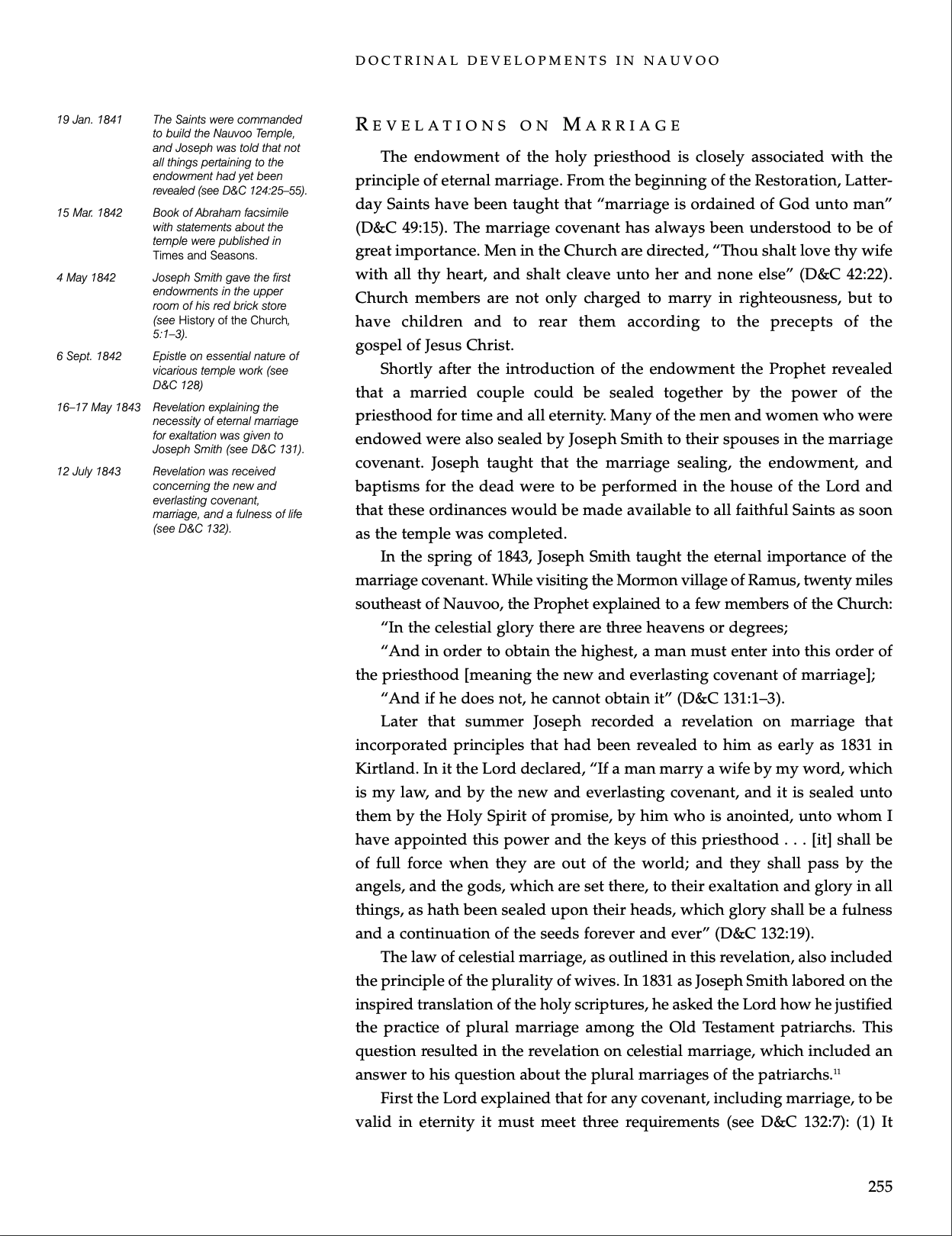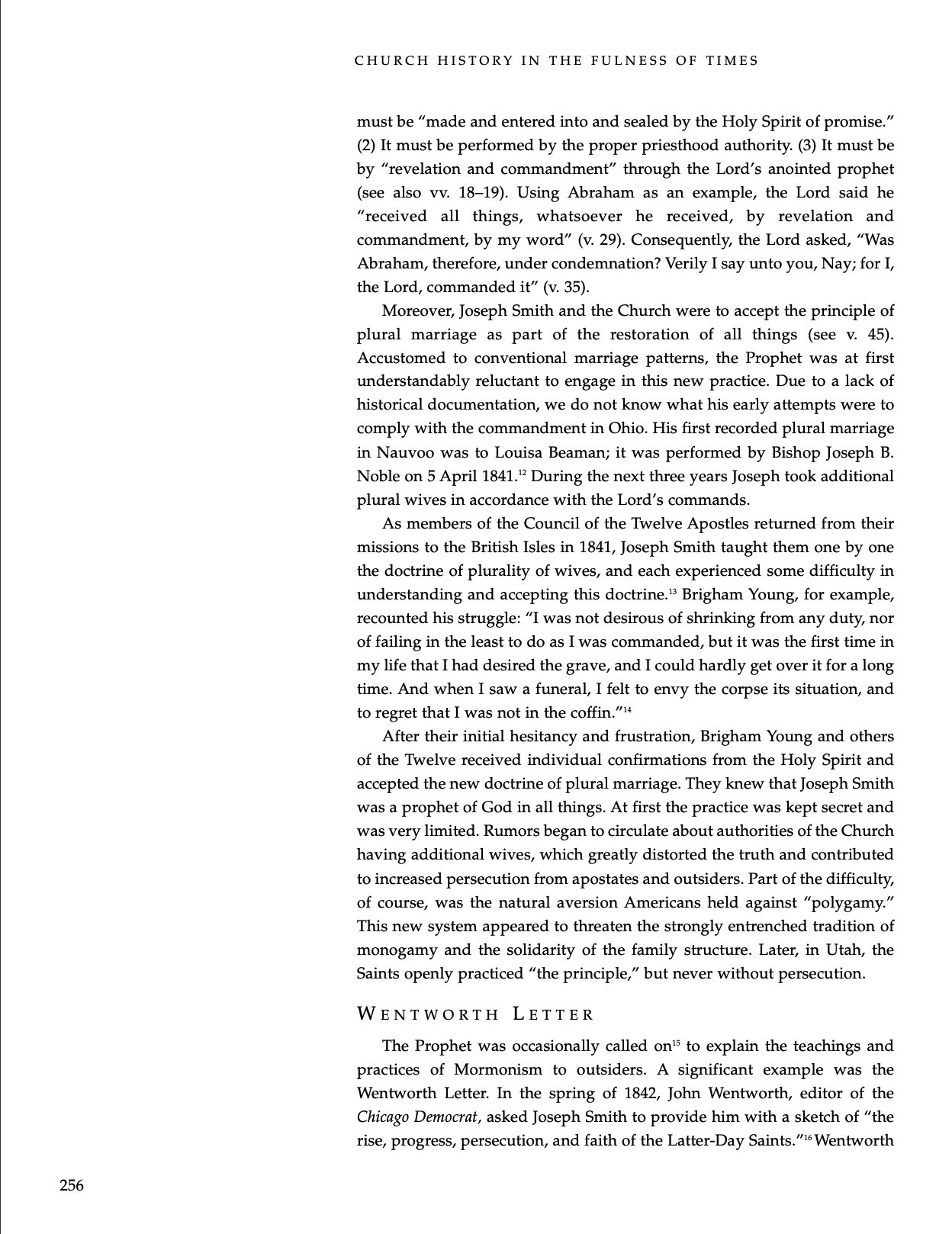Church Institute manual discusses the history of plural marriage.
- Type
- Book
- Source
- The Church of Jesus Christ of Latter-day Saints LDS
- Hearsay
- Direct
- Reference
Church History in the Fulness of Times: The History of The Church of Jesus Christ of Latter-day Saints, 2nd ed. (Salt Lake City, UT: The Church of Jesus Christ of Latter-day Saints, 2003), 255–256
- Scribe/Publisher
- The Church of Jesus Christ of Latter-day Saints
- Audience
- Reading Public
- Transcription
Revelations on Marriage
The endowment of the holy priesthood is closely associated with the principle of eternal marriage. From the beginning of the Restoration, Latter-day Saints have been taught that “marriage is ordained of God unto man” (D&C 49:15). The marriage covenant has always been understood to be of great importance. Men in the Church are directed, “Thou shalt love thy wife with all thy heart, and shalt cleave unto her and none else” (D&C 42:22). Church members are not only charged to marry in righteousness, but to have children and to rear them according to the precepts of the gospel of Jesus Christ.
Shortly after the introduction of the endowment the Prophet revealed that a married couple could be sealed together by the power of the priesthood for time and all eternity. Many of the men and women who were endowed were also sealed by Joseph Smith to their spouses in the marriage covenant. Joseph taught that the marriage sealing, the endowment, and baptisms for the dead were to be performed in the house of the Lord and that these ordinances would be made available to all faithful Saints as soon as the temple was completed.
In the spring of 1843, Joseph Smith taught the eternal importance of the marriage covenant. While visiting the Mormon village of Ramus, twenty miles southeast of Nauvoo, the Prophet explained to a few members of the Church:
“In the celestial glory there are three heavens or degrees;
“And in order to obtain the highest, a man must enter into this order of the priesthood [meaning the new and everlasting covenant of marriage];
“And if he does not, he cannot obtain it” (D&C 131:1–3).
Later that summer Joseph recorded a revelation on marriage that incorporated principles that had been revealed to him as early as 1831 in Kirtland. In it the Lord declared, “If a man marry a wife by my word, which is my law, and by the new and everlasting covenant, and it is sealed unto them by the Holy Spirit of promise, by him who is anointed, unto whom I have appointed this power and the keys of this priesthood … [it] shall be of full force when they are out of the world; and they shall pass by the angels, and the gods, which are set there, to their exaltation and glory in all things, as hath been sealed upon their heads, which glory shall be a fulness and a continuation of the seeds forever and ever” (D&C 132:19).
The law of celestial marriage, as outlined in this revelation, also included the principle of the plurality of wives. In 1831 as Joseph Smith labored on the inspired translation of the holy scriptures, he asked the Lord how he justified the practice of plural marriage among the Old Testament patriarchs. This question resulted in the revelation on celestial marriage, which included an answer to his question about the plural marriages of the patriarchs.11
First, the Lord explained that for any covenant, including marriage, to be valid in eternity it must meet three requirements (see D&C 132:7): (1) It must be “made and entered into and sealed by the Holy Spirit of promise.” (2) It must be performed by the proper priesthood authority. (3) It must be by “revelation and commandment” through the Lord’s anointed prophet (see also vv. 18–19). Using Abraham as an example, the Lord said he “received all things, whatsoever he received, by revelation and commandment, by my word” (v. 29). Consequently, the Lord asked, “Was Abraham, therefore, under condemnation? Verily I say unto you, Nay; for I, the Lord, commanded it” (v. 35).
Moreover, Joseph Smith and the Church were to accept the principle of plural marriage as part of the restoration of all things (see v. 45). Accustomed to conventional marriage patterns, the Prophet was at first understandably reluctant to engage in this new practice. Due to a lack of historical documentation, we do not know what his early attempts were to comply with the commandment in Ohio. His first recorded plural marriage in Nauvoo was to Louisa Beaman; it was performed by Bishop Joseph B. Noble on 5 April 1841.12 During the next three years Joseph took additional plural wives in accordance with the Lord’s commands.
As members of the Council of the Twelve Apostles returned from their missions to the British Isles in 1841, Joseph Smith taught them one by one the doctrine of plurality of wives, and each experienced some difficulty in understanding and accepting this doctrine. Brigham Young, for example, recounted his struggle: “I was not desirous of shrinking from any duty, nor of failing in the least to do as I was commanded, but it was the first time in my life that I had desired the grave, and I could hardly get over it for a long time. And when I saw a funeral, I felt to envy the corpse its situation, and to regret that I was not in the coffin.”
After their initial hesitancy and frustration, Brigham Young and others of the Twelve received individual confirmations from the Holy Spirit and accepted the new doctrine of plural marriage. They knew that Joseph Smith was a prophet of God in all things. At first the practice was kept secret and was very limited. Rumors began to circulate about authorities of the Church having additional wives, which greatly distorted the truth and contributed to increased persecution from apostates and outsiders. Part of the difficulty, of course, was the natural aversion Americans held against “polygamy.” This new system appeared to threaten the strongly entrenched tradition of monogamy and the solidarity of the family structure. Later, in Utah, the Saints openly practiced “the principle,” but never without persecution.
- Citations in Mormonr Qnas
The B. H. Roberts Foundation is not owned by, operated by, or affiliated with the Church of Jesus Christ of Latter-day Saints.


